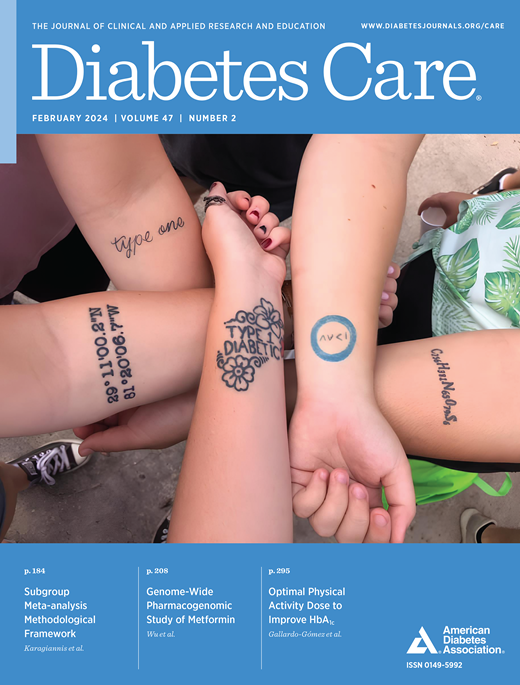无症状成人糖尿病患者是否需要心衰和外周动脉疾病筛查?2025年美国糖尿病协会《糖尿病护理标准》展望
IF 16.6
1区 医学
Q1 ENDOCRINOLOGY & METABOLISM
引用次数: 0
摘要
美国糖尿病协会(ADA)每年发布“糖尿病护理标准”(SOC),为临床医生、患者和付款人提供糖尿病管理的循证指南。2025 SOC建议临床医生考虑使用利钠肽水平筛查无症状成人糖尿病患者的心力衰竭,并使用踝-肱指数(ABI)测试筛查无症状糖尿病患者≥65岁,伴有微血管疾病、足部并发症或糖尿病终末器官损伤的外周动脉疾病(PAD)。本观点使用已建立的筛选原则和已发表的文献来评估这些建议。使用利钠肽筛查心力衰竭的建议在几个关键领域缺乏强有力的证据。n端前b型利钠肽,或NT-proBNP,本身在无症状成人的筛查试验中表现不佳。此外,治疗建议存在歧义,并且没有足够的证据表明钠-葡萄糖共转运蛋白2抑制剂治疗对成人糖尿病和B期心力衰竭的预后有改善。最后,所涉及的成本很高,在经济上可能不合理。同样,对无症状成人糖尿病患者进行PAD筛查的建议也没有严格的科学证据支持。所引用的证据将ABI筛查与其他有效的筛查试验结合起来,具有有限的通用性。目前还没有关于如何解释ABI检测结果或如何使用所获得的信息来指导治疗的指南。虽然通过筛查改善保健的意图值得赞扬,但这些建议没有得到筛查原则和已发表文献的充分支持。ADA必须使用最大的科学严谨性来准备其SOC。本文章由计算机程序翻译,如有差异,请以英文原文为准。
Is Screening for Heart Failure and Peripheral Artery Disease Warranted in Asymptomatic Adults With Diabetes? A Perspective on the 2025 American Diabetes Association “Standards of Care in Diabetes”
The American Diabetes Association (ADA) publishes the “Standards of Care in Diabetes” (SOC) annually to offer clinicians, patients, and payers evidence-based guidelines for diabetes management. The 2025 SOC recommends that clinicians consider screening asymptomatic adults with diabetes for heart failure using natriuretic peptide levels, and that they screen asymptomatic adults with diabetes ≥65 years of age with any microvascular disease, foot complications, or end-organ damage from diabetes for peripheral artery disease (PAD) using ankle-brachial index (ABI) testing. This perspective evaluates those recommendations using established screening principles and the published literature. The recommendation to screen for heart failure using natriuretic peptide lacks robust evidence in several key areas. N-terminal pro-B-type natriuretic peptide, or NT-proBNP, itself performs poorly as a screening test in asymptomatic adults. Furthermore, there is ambiguity in treatment recommendations and insufficient evidence showing improved outcomes with sodium–glucose cotransporter 2 inhibitor treatment in adults with diabetes and stage B heart failure. Finally, the costs involved are high and may not be economically justifiable. Similarly, the recommendation to screen for PAD in asymptomatic adults with diabetes is not backed by rigorous scientific evidence. The evidence cited combines ABI screening with other effective screening tests and has limited generalizability. There is no guidance on how to interpret the results of ABI testing or how the information gained should be used to direct treatment. While the intent to improve health care through screening is commendable, these recommendations are inadequately supported by the principles of screening and the published literature. It is imperative that the ADA uses the greatest scientific rigor to prepare its SOC.
求助全文
通过发布文献求助,成功后即可免费获取论文全文。
去求助
来源期刊

Diabetes Care
医学-内分泌学与代谢
CiteScore
27.80
自引率
4.90%
发文量
449
审稿时长
1 months
期刊介绍:
The journal's overarching mission can be captured by the simple word "Care," reflecting its commitment to enhancing patient well-being. Diabetes Care aims to support better patient care by addressing the comprehensive needs of healthcare professionals dedicated to managing diabetes.
Diabetes Care serves as a valuable resource for healthcare practitioners, aiming to advance knowledge, foster research, and improve diabetes management. The journal publishes original research across various categories, including Clinical Care, Education, Nutrition, Psychosocial Research, Epidemiology, Health Services Research, Emerging Treatments and Technologies, Pathophysiology, Complications, and Cardiovascular and Metabolic Risk. Additionally, Diabetes Care features ADA statements, consensus reports, review articles, letters to the editor, and health/medical news, appealing to a diverse audience of physicians, researchers, psychologists, educators, and other healthcare professionals.
 求助内容:
求助内容: 应助结果提醒方式:
应助结果提醒方式:


